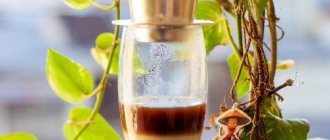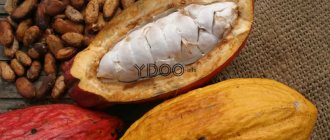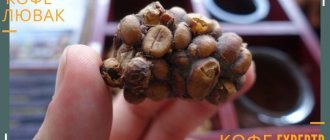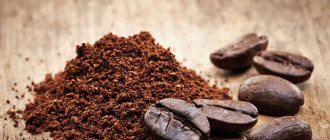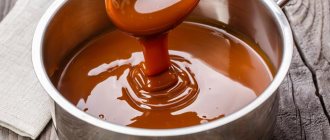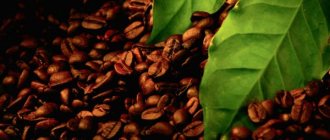Classic Vietnamese coffee – rich, strong and sweet. It is prepared in a special metal filter - fine, often with very dark roasted Robusta or Arabica with condensed milk. A cup of traditional Vietnamese coffee is an instant boost of energy. It is not surprising that in Vietnam this drink is called “rocket fuel”.
There are other recipes for making coffee using a Vietnamese filter. The main advantage of this brewing method is its simplicity. The ability to get a very tasty, balanced cup of coffee without any extra effort.
In the article you will learn:
- What is Vietnamese coffee?
- How is coffee prepared in Vietnam?
- How to make Vietnamese coffee at home?
- Three ways to make Vietnamese coffee: black, sweet and cold
History of the drink
Vietnam was a colony of France for a long time - from the 1880s to 1954. In 1857, Catholic missionaries brought the first coffee bushes to the country from the French island of Reunion. The colonists found it economically profitable to produce coffee for export. In 1908, new species were introduced into the country - robusta and liberica. In 1945, trees occupied an area of about 10 thousand hectares, and about 4,500 tons of product were produced annually. Most of the products were supplied to France.
The focus on the global market appeared after the creation of the Socialist Republic of Vietnam in 1976. The scale of coffee production doubled, and large state cooperatives emerged.
At the end of the 1970s. There is an active development of the Central Highlands (Tainguen) - a plateau in the south of the country: many coffee fields have appeared there. Since 1989, the integration of the Vietnamese economy into the world economy began, and by 2000, the coffee industry (compared to 1976) had grown 100 times.
In 2001, Vietnam joined the International Coffee Organization and the Association of Coffee Producing Countries. The country began to curb the production of low-quality raw materials in order to meet international standards. In 2009, the share of Vietnamese coffee amounted to 18% of global coffee production; Vietnam is second only to Brazil in terms of exports.
At the end of 2021, the World Coffee Museum was opened in Dak Lak province. Equipped in the style of the dwellings of the ethnic peoples of the Central Plateau, it recalls the time when new territories were being developed for plantations.
Story
The French brought coffee to Vietnam in 1857, since then this Asian country began to slowly but surely become a producer of the popular drink. Until the beginning of the 20th century, grains were grown in small households, then producers switched to a plantation system.
During the Vietnam War of 1955-1975, coffee production was suspended, then the state collectivized agricultural production. Private farms appeared only in 1986. From that moment on, the coffee industry began to develop and grow, new brands appeared, and after 12 years, Vietnam confidently took second place in the world in coffee production after Brazil.
By 2000, coffee production in Vietnam reached 900 thousand tons per year.
Vietnamese coffee provinces
The first fields appeared in 1888. They were located in Nghe An province. Then they started growing trees in the southern provinces - Thanh Hoa, Ha Tinh, and in the central ones - Quang Binh and Quang Tri.
Climatic conditions affected the taste and aroma of the product.
Vast fields - more than 600 thousand hectares - appeared in 1898 on the Teing Guen plateau, in the Central mountainous region. The optimal climate for growing coffee raw materials is in the vicinity of the city of Dalat (Lam Dong province), and the largest coffee shops are located in the city itself, which is called little Paris.
The main grain producer is Dak Lak province. Plantations covering an area of 506 thousand hectares produce an annual harvest of about 1 million tons. The administrative center of the province, Buon Ma Thuot, is considered the capital of coffee.
In modern Vietnam, plantations are located in almost every corner of the country. The plots are numerous and small: from 1 to 5 hectares, only 1% of all products are grown on plantations larger than 5 hectares.
Characteristics of coffee
As a raw material, it is represented by 2 popular pure types:
- Arabica (accounts for about 14% of all products);
- robusta (85% of production).
Robusta is a strong variety that contains almost 3 times more caffeine than Arabica. It is inexpensive and therefore forms the basis of Vietnamese drinks. More expensive Arabica is the basis for elite varieties or is added to Robusta to give a delicate flavor.
Robusta forms the basis of Vietnamese drinks.
Vietnamese coffee is exported in ground, instant and bean forms. In Russia, ground and instant products are still rare.
Taste characteristics
The drink has a rich taste and strong pleasant aroma, and is less bitter than Brazilian or Indonesian coffee. May have the following flavors:
- chocolate;
- vanilla;
- caramel;
- cream;
- nuts.
These characteristics depend on the characteristics of the variety, production, roasting and the ratio of Arabica to Robusta.
Beneficial features
The chemical composition of coffee has a beneficial effect on the human body:
- caffeine - reduces fatigue, increases productivity, speeds up metabolism;
- vitamin P - strengthens capillaries;
- antioxidants - prevent the aging of the body, reduce the risk of developing cancer;
- chlorogenic acid - normalizes the functioning of the gastrointestinal tract;
- trigonelline - prevents the development of atherosclerosis;
- nicotinic acid - lowers cholesterol levels;
- polysaccharides - increase brain activity;
- tannins - improve digestion.
Coffee reduces fatigue and increases productivity.
In addition, coffee:
- stimulates the functioning of internal organs and mental activity, so its moderate consumption is the prevention of Alzheimer’s and Parkinson’s diseases;
- eliminates migraine;
- is an antidepressant;
- has an antiallergic effect, because reduces the level of histamines;
- helps with intoxication of the body with drugs or poisons.
Despite the extensive list of beneficial properties of the product, it is not recommended to exceed the daily norm of the drink - 3-4 cups of 240 ml.
Secrets of the variety
Let's try to reveal the main secret of the unique Vietnamese coffee. The producers of the famous Kopi Luwak are musangs. These beautiful palm martens (civets) are directly involved in the technological chain of creating coffee beans. Musangs feed on berries from coffee plantations. The pulp is digested in the stomachs of the animals, and the grains, along with the droppings, naturally come out.
Special employees collect the droppings, wash and dry them to create an elite drink. Note that animal excrement does not have any effect on coffee beans. Instead of the supposed unpleasant smell, Kopi Luwak has a delicious, subtle aroma. Otherwise, there would be few people willing to taste the expensive drink.
The main secret of the participation of Vietnamese animals in the technology of coffee production is that a special fermentation of coffee beans occurs in their stomachs. The bitterness disappears, and Vietnamese luwak acquires a rich and refined taste.
Tourists are often told the legend of the discovery of the unique properties of elite Vietnamese coffee. The harvest of grains prepared by a poor peasant family for sale was completely eaten by wild musangs. The Vietnamese were able to isolate undigested grains from animal feces, fry them, and offer them to customers. Imagine their amazement when they not only bought the coffee, but the buyers appreciated the unusual taste and delicate aroma.
Currently, making this exclusive coffee from animal excrement has become problematic and quite expensive. The most expensive beans of Luwak coffee are those collected in the natural environment. Searching for and collecting grains is quite difficult. That is why special farms began to appear in the country where musangs are bred.
The animals are fed with ripe coffee berries. Raising palm martens is quite difficult and expensive, so farmers have to constantly work. The raw materials that emerge from the digestive tract of the musang are collected by the Vietnamese by hand. Each grain is thoroughly washed and then dried under natural sunlight.
Production Features
Peasants prefer to plant coffee trees next to fruit trees or just tall plants that bring additional income, such as corn.
Coffee trees are planted next to fruit trees.
In the natural shade, the berries ripen longer and absorb more nutrients, which will later provide the drink with a rich taste.
Harvesting:
- Robusta - September-October. Ripe fruits can hang on a branch for a long time without falling off. This allows you to start harvesting when almost all the berries are ripe. Robusta is harvested using the stripping method - with a sliding movement of the hand, the fruits are peeled from the branch onto a canvas spread on the ground.
- Arabica - September-October. The fruits ripen unevenly; 2-3 approaches to one tree are required to collect the entire harvest. The method is called manual picking, i.e. Ripe berries are selectively collected, leaving the green ones to ripen.
Mechanized processing of collected berries is carried out only in a few large factories. Basically all work is done manually.
The technology is different:
- Dry or natural method. The fruits are scattered in a thin layer on a canvas or in a sieve and left to dry naturally for a week. Periodically stir with your hands or a spatula.
- Semi-moist method. The berries are dried a little, then the skin, pulp, gluten and patch are mechanically removed. Wash and dry.
- Wet. Allows you to obtain high quality products; it is often used when processing Arabica beans. When washing, the fruits are immersed in water and the floating unripe berries are removed. After treatment with a depulpator (like a grater, designed to separate the pulp from the peel), the grains are sent to dry.
The next step is fermentation to remove gluten. The grains are again immersed in water for 12-36 hours.
As a result of the action of bacteria, the gluten itself will begin to peel off. The grains are then dried and, after hulling (husking), manually sorted and either packaged or sent for roasting.
Signature roast
The secret of the unique taste and smell of Vietnamese coffee is in roasting the beans along with cocoa beans. This method is used only within the country.
Signature roasting is the secret of the unique taste of coffee.
To give the product additional flavor shades, add:
- powdered milk;
- diluted condensed milk;
- fruit syrup;
- sugar;
- hazelnut or walnut oil.
Classic Vietnamese coffee is highly roasted; coconut oil is added to the cocoa beans.
Strong, tasty, aromatic
Passionate lovers of Vietnamese coffee in our country mostly order it online. It happens that we went to Vietnam to sunbathe and returned as avid coffee drinkers. Moreover, German, Swiss and even Italian brands cannot replace the Vietnamese miracle.
What's so special about coffee in Vietnam? “Strong, aromatic, tart”, “Unusually rich with chocolate notes”, “Creamy taste, unique aroma” - this is how connoisseurs characterize Vietnamese coffee. Even those who were skeptical about the laudatory reviews, believing that all coffee was approximately the same, immediately felt the difference after trying it.
And few people agree to return to brewing the contents of packs from the nearest supermarket. Well, Vietnam is not so far away, you can fly for coffee like this!


